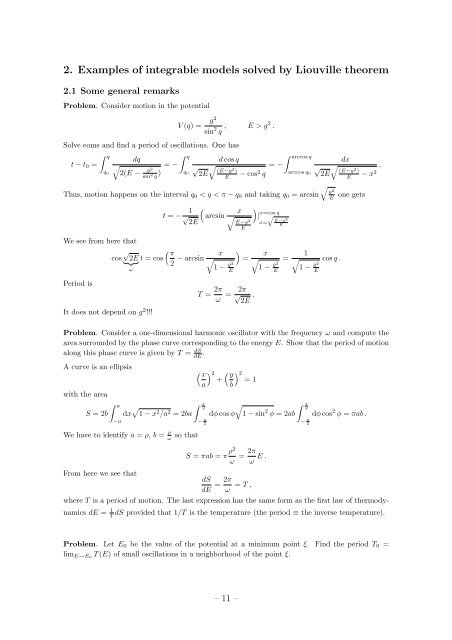Student Seminar: Classical and Quantum Integrable Systems
Student Seminar: Classical and Quantum Integrable Systems
Student Seminar: Classical and Quantum Integrable Systems
You also want an ePaper? Increase the reach of your titles
YUMPU automatically turns print PDFs into web optimized ePapers that Google loves.
2. Examples of integrable models solved by Liouville theorem<br />
2.1 Some general remarks<br />
Problem. Consider motion in the potential<br />
V (q) =<br />
Solve eoms <strong>and</strong> find a period of oscillations. One has<br />
t − t 0 =<br />
∫ q<br />
q 0<br />
dq<br />
√<br />
= −<br />
2(E − g2<br />
sin 2 q )<br />
∫ q<br />
q 0<br />
g2<br />
sin 2 q , E > g2 .<br />
d cos q<br />
√ √<br />
2E<br />
(E−g 2 )<br />
E<br />
− cos 2 q<br />
∫ arccos q<br />
= −<br />
arccos q 0<br />
Thus, motion happens on the interval q 0 < q < π − q 0 <strong>and</strong> taking q 0 = arcsin<br />
We see from here that<br />
Period is<br />
cos √ } {{<br />
2E<br />
}<br />
ω<br />
It does not depend on g 2 !!!<br />
t = − 1 √<br />
2E<br />
(<br />
arcsin<br />
x<br />
√<br />
E−g 2<br />
E<br />
( π<br />
t = cos<br />
2 − arcsin x<br />
)<br />
√ =<br />
1 − g2<br />
E<br />
T = 2π ω =<br />
)<br />
2π √<br />
2E<br />
.<br />
| x=cos q<br />
q<br />
E−g<br />
x=<br />
2<br />
E<br />
x<br />
√<br />
1 − g2<br />
E<br />
dx<br />
√ √ .<br />
2E<br />
(E−g 2 )<br />
E<br />
− x 2<br />
√<br />
g 2<br />
E<br />
= √<br />
1<br />
cos q .<br />
1 − g2<br />
E<br />
one gets<br />
Problem. Consider a one-dimensional harmonic oscillator with the frequency ω <strong>and</strong> compute the<br />
area surrounded by the phase curve corresponding to the energy E. Show that the period of motion<br />
along this phase curve is given by T = dS<br />
dE .<br />
A curve is an ellipsis<br />
( x<br />
a<br />
) 2<br />
+<br />
( y<br />
b<br />
) 2<br />
= 1<br />
with the area<br />
S = 2b<br />
∫ a<br />
−a<br />
dx √ ∫ π √<br />
1 − x 2 /a 2 2<br />
= 2ba dφ cos φ 1 − sin 2 φ = 2ab<br />
− π 2<br />
∫ π<br />
2<br />
− π 2<br />
dφ cos 2 φ = πab .<br />
We have to identify a = ρ, b = ρ ω<br />
so that<br />
S = πab = π ρ2<br />
ω = 2π ω E .<br />
From here we see that<br />
dS<br />
dE = 2π ω = T ,<br />
where T is a period of motion. The last expression has the same form as the first law of thermodynamics<br />
dE = 1 T<br />
dS provided that 1/T is the temperature (the period ≡ the inverse temperature).<br />
Problem. Let E 0 be the value of the potential at a minimum point ξ. Find the period T 0 =<br />
lim E→E0 T (E) of small oscillations in a neighborhood of the point ξ.<br />
– 11 –

















